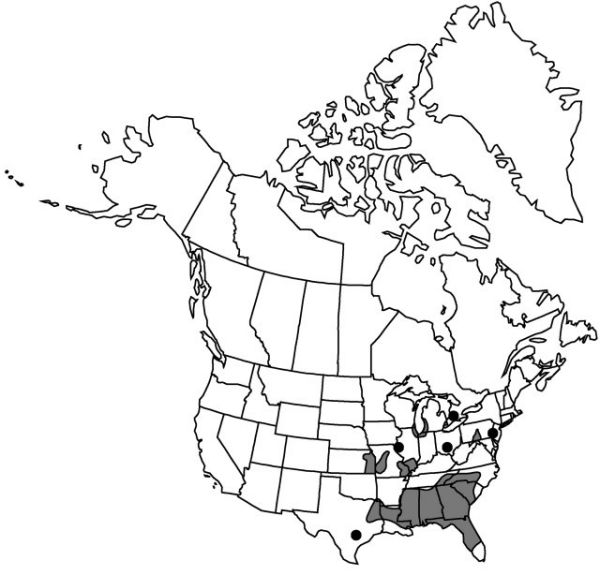Yucca flaccida
Suppl. Pl. Succ., 34. 1819.
Plants cespitose, forming small colonies, erect, acaulescent or rarely short-caulescent, 1–3 m; rosettes usually small, slowly dying after flowering. Stems simple, to 0.3 m. Leaf blade erect, proximal leaves becoming reflexed at middle in age, lanceolate, gradually tapering to apex, thin, widest near middle, 40–80 × 1–4(–5) cm, rigid or soft and limp, glabrous, margins entire, filiferous, apex spinose. Inflorescences paniculate, arising beyond rosettes, narrowly ovoid, 4–15 dm, mostly pubescent; bracts erect, proximal to 25 cm, distal 2–3 cm; peduncle scapelike, 0.5–2.8 m, 0.5–4 cm diam. Flowers pendent; tepals distinct, white, creamy white, or light greenish white, lanceolate to elliptic, 3–5 × 1–3 cm, mostly pubescent, apex obtuse; filaments 1.2–2.2 cm; pistil 1.5–3.8 cm; ovary pale green, 1.5 cm; style greenish white to white, papillate; stigmas lobed; pedicel 1.5–3 cm. Fruits erect, capsular, dehiscent, oblong, obpyriform, or conical, 3.5–4 × 1.5–2 cm, dehiscence septicidal. Seeds dull black, thin, 6–8 × 5–6 mm.
Phenology: Flowering spring.
Habitat: Sand pine-scrub oak, mixed pine-hardwood woodlands, old fields, coastal sands, open or semiopen sites and pine plantations
Distribution

Ont., Ala., Ark., Fla., Ga., Ill., Ind., Kans., La., Md., Mich., Miss., Mo., N.C., Ohio, Okla., Pa., S.C., Tenn., Tex., Wis.
Discussion
Perhaps Yucca flaccida should be considered a variety of Y. filamentosa. The morphological differences are minor. The former has thinner, narrower leaves, and smaller, narrower flowers 4–5 cm long, whereas Y. filamentosa has thick, rigid leaves and flowers 5–7 cm long. Yucca freemanii was described from plants growing in northeastern Texas and southwestern Arkansas. These plants were reported to be glabrous, but some plants that are otherwise attributable to Y. freemanii are mostly pubescent through the infloresecence, and overall they fall within the variation range of Y. flaccida. Yucca flaccida is cultivated in some of the northern states and Canada, where it sometimes has naturalized.
The results of DNA studies by K. H. Clary (1997) are incongruent with our treatment of Yucca flaccida, which warrants further research. It is the only dry-fruited species that groups with the fleshy-fruited ones in Clary’s consensus tree, where Y. flaccida and Y. filamentosa are quite distant. DNA variation indicates that Y. louisianensis is genetically distinct and more closely related to Y. filamentosa than to Y. flaccida.
Selected References
None.